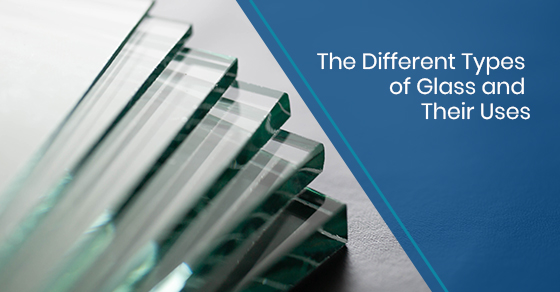
Glass is often mistakenly viewed as a highly fragile material with limited uses. However, glass has been used for both decorative and practical purposes since its invention. With advances in technology, glass has become a very popular material in construction, interior design, and furniture. There are now several glass types and treatments available, making it easy to find a suitable type of glass for just about any application. From security to interior design, to UV protection to furnishings, here are the many different glass types and their uses.
Flat glass is used for windows and glass doors. This glass is used as the base to create many other types of glass and is produced in the float process during the first steps of glass making. It comes in a basic thickness from which it can then undergo additional processing to make it safer and suitable for other uses, such as double-glazing for insulated windows and glass doors. Without further treatments, though, flat glass is fragile and prone to breaking in dangerous, sharp shards. This increases the risk of injury when the glass is broken.
Tempered glass is a popular choice for shower doors, glass furniture, and glass shelves. It’s resistant to shattering due to the special cooling process used to create it. When shattered, the glass crumbles into small, smooth pieces as opposed to dangerous jagged shards. As a result, tempered glass is safer, both during accidents as well as for cleaning up. This type of glass can also be treated with sandblasting and acid etching to create a frosted look for privacy.
This glass helps blur the transparency level, making it a good choice for doors and bathroom windows. The glass sheets are heated and then passed through patterned rollers that leave an imprint. It allows light to shine through, but also adds a textured feel to the glass that adds more depth and clarity when compared to the frosted effect of blasting. The transparency and clarity of the glass remain intact, so it has more sparkle and creates an interesting effect when light falls behind it. The level of transparency varies based on the intricacy of the pattern design. Patterns can create different effects such as Jack Frost, trickling water, mottling, swirls, and even the appearance of broken glass. The glass is not only an excellent option for privacy walls and showers, but also creates highly detailed textured glass tables and desks. It can also be used for customized glass door inserts in combination with metals and wood, or it can be inserted on walls as textured glass protection to reduce wear and tear.
Mirrored glass is used for wardrobe doors, bathroom mirrors, and closet doors. It comes in a variety of styles and colours made by applying metal coatings to glass. Common colours include silver, chrome, gold, and aluminum, but other finishes can appear marbled, smokey, and tinged with hints of other metallics. Mirrored glass can also be used as a wall treatment to create a feeling of openness as well as backsplashes in kitchens and bathrooms.
Coated glass uses include double-glazed windows, as it has been modified to provide insulating qualities as well as to cut down on UV rays. Home windows today are coated, as they help improve energy efficiency. With new thermal windows made of coated glass, you can improve thermal efficiency, which can help reduce energy consumption and the cost of heating and cooling your home.
As the name implies, tinted glass contains a tinted glaze consisting of metal oxides. Tinted glass uses include doors and windows to provide privacy while allowing light to shine through. Tinted glass is also used to reduce the glare of the sun, making it a good choice for south-facing rooms, as well as rooms where viewing screens are used. It can reduce UV rays, which means furnishings, curtains, and rugs will not fade, and your family can be protected from the harmful rays of the sun.
As mentioned above, sandblasting can be applied to glass to provide privacy for areas such as bathrooms or to create a decorative effect. Commonly referred to as frosted glass, it can be used in any number of applications, whether it’s for practical purposes such as privacy in offices, bathrooms, and showers, or as an interior design feature. The glass is blasted at high pressure using an abrasive that leaves behind a frosted appearance. Sandblasting is ideal for larger glass projects, as it is more consistent across larger areas than other techniques such as acid etching.
Acid-etched glass uses acid instead of blasting to create customized designs on glass walls and other glass features. It adds privacy with the same look as sandblasted glass, allowing light to filter through. The acid is used to remove the glass surface to create the white tones. Designs can also be created using a non-reactive substance, such as wax. Acid-etched glass is preferable if you are looking for a complex design. It’s less prone to fingerprints when compared to a finish such as sandblasting. As well, it’s often more affordable than sandblasting.
At Glass Showers and More, our team of glass experts can explain the various glass types to help you come up with unique ideas for your home or office. Click here to contact us today.

Glass Showers and More is a leading provider of custom glass and mirror products serving home builders, contractors and home-owners in the Greater Toronto Area. With our in-house fabrication capabilities, we are able to provide our customers with highly customized solutions for all of their glass needs. Our team of product experts and installers allows us to provide a truly turn-key glass solution to our customers.